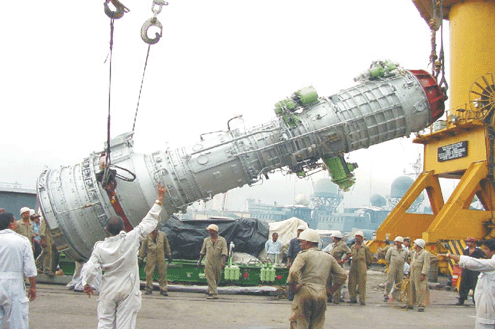 The K family of missiles is a series of submarine-launched ballistic missiles (SLBM) developed by India to boost its second-strike capabilities and thus the nuclear deterrence. Information about this family of missiles has mostly been kept secret. In November 2010, India Today featured an article named “The secret ‘K’ missile family” that gave away some details about what they called as the “Black Project” which DRDO officials are covertly working on. It further stated, “The top secret indigenous “K” missiles are faster, lighter and stealthier.”
The K family of missiles is a series of submarine-launched ballistic missiles (SLBM) developed by India to boost its second-strike capabilities and thus the nuclear deterrence. Information about this family of missiles has mostly been kept secret. In November 2010, India Today featured an article named “The secret ‘K’ missile family” that gave away some details about what they called as the “Black Project” which DRDO officials are covertly working on. It further stated, “The top secret indigenous “K” missiles are faster, lighter and stealthier.”
Missiles in the series
K-15 or Sagarika
The Sagarika/K-15 missile (Sanskrit: सागरिका, IAST:Sāgarikā, meaning Oceanic) is the SLBM version of the land-based Shaurya missile. With a shorter range than K-4 missiles it is to be integrated with Arihant class submarine concurrently developed for the use of Indian Navy.
Sagarika/K-15 was developed at the DRDO’s missile complex in Hyderabad. The complex consists of the Defence Research and Development Laboratory (DRDL), the Advanced Systems Laboratory (ASL) and the Research Centre, Imarat (RCI).
DRDL designed and developed the missile, while the ASL provided the motors and propulsion systems. The RCI’s contribution was in avionics, including control and guidance systems and inertial navigation systems. K-15 has a range of around 700 km with 1,000 kg warhead and around 1,900 km with 180 kg warhead. This will also get help from Indian Regional Navigation Satellite System (IRNSS), expected to be ready by 2014, to ensure guaranteed national access to precision navigation. These will enable high accuracy required for precision strike.
K-4 Missile
K-4, named after former President of India Dr. APJ Abdul Kalam, is the next significant development under the K-X series by DRDO. It was covertly tested off the coast of Visakhapatnam in January, 2010. However, any detail regarding the developments in this project are confidential and this project is sometimes referred to as “BLACK PROJECT” whose existence is neither denied nor acknowledged by DRDO. While there are some reports that claim that K-4 is a submarine launched version of AGNI-V, other reports state that it is actually a SLBM Version of the Agni-III missile that is being worked on. The goal of this project is to expand the second-strike options for the country, DRDO scientists told reporters during a briefing. A total of 258 private firms and 20 DRDO laboratories were involved in this venture. The Missile is said to have two variants. One with a range of 3,500 km that is 10 m long and the other with a range of 5,000 km will be 12 m long to arm future nuclear submarines of the Arihant class. K-4 will provide India the capability to target China and Pakistan simultaneously. INS Arihant, first of the Arihant Class Submarines, will be able to carry 4 (10m long) K-4s or 12 K-15s.
K-5 Missile
- K-5 missile is the SLBM version of AGNI-VI (ICBM) is allegedly under development by DRDO. And it will arm the future variants of Arihant class submarines of the Indian Navy. DRDO revealed in 2011 that it is also in the process of developing a variant of Agni missiles which will be a submarine launched solid fuel missile with a maximum range of 6,000 kilometers and a payload of one tonne. However, there is strong opacity regarding the existence of such a project.
| TYPE | RANGE | Weight | Warhead | length | Status |
|---|---|---|---|---|---|
| K-15 | 750 km | 10 tonnes | 1 tonne | 10 m | K-15/B-05 in series production. Land-based missile awaiting clearance. |
| K-4 | 3,500-5,000 km | 17 tonnes | 1 tonneto 2.5 tonnes(depending upon the variant) | 10 m | |
| Air Launched | 200 km | 2 tonnes | 500 kg | 4 m | Hypersonic missile project called ‘Air launched article’. It is designated to fit with Sukhoi Su-30-MKI. First prototype will be ready by 2012. |
| K-5 (SLBM Version of AGNI-VI) | 6,000 km | Unspecified | 1 tonne | Unspecified | Under Development by DRDO |


